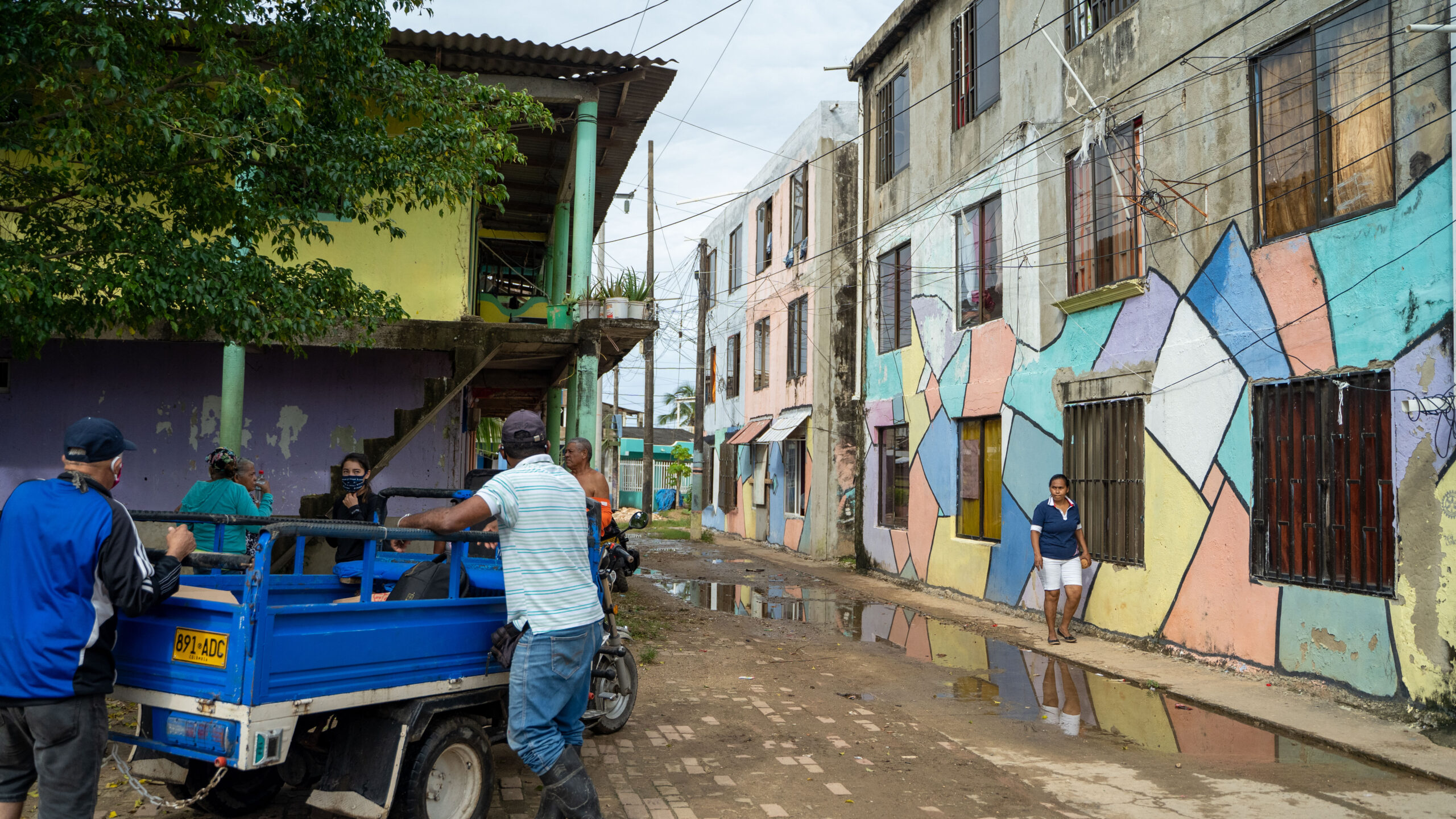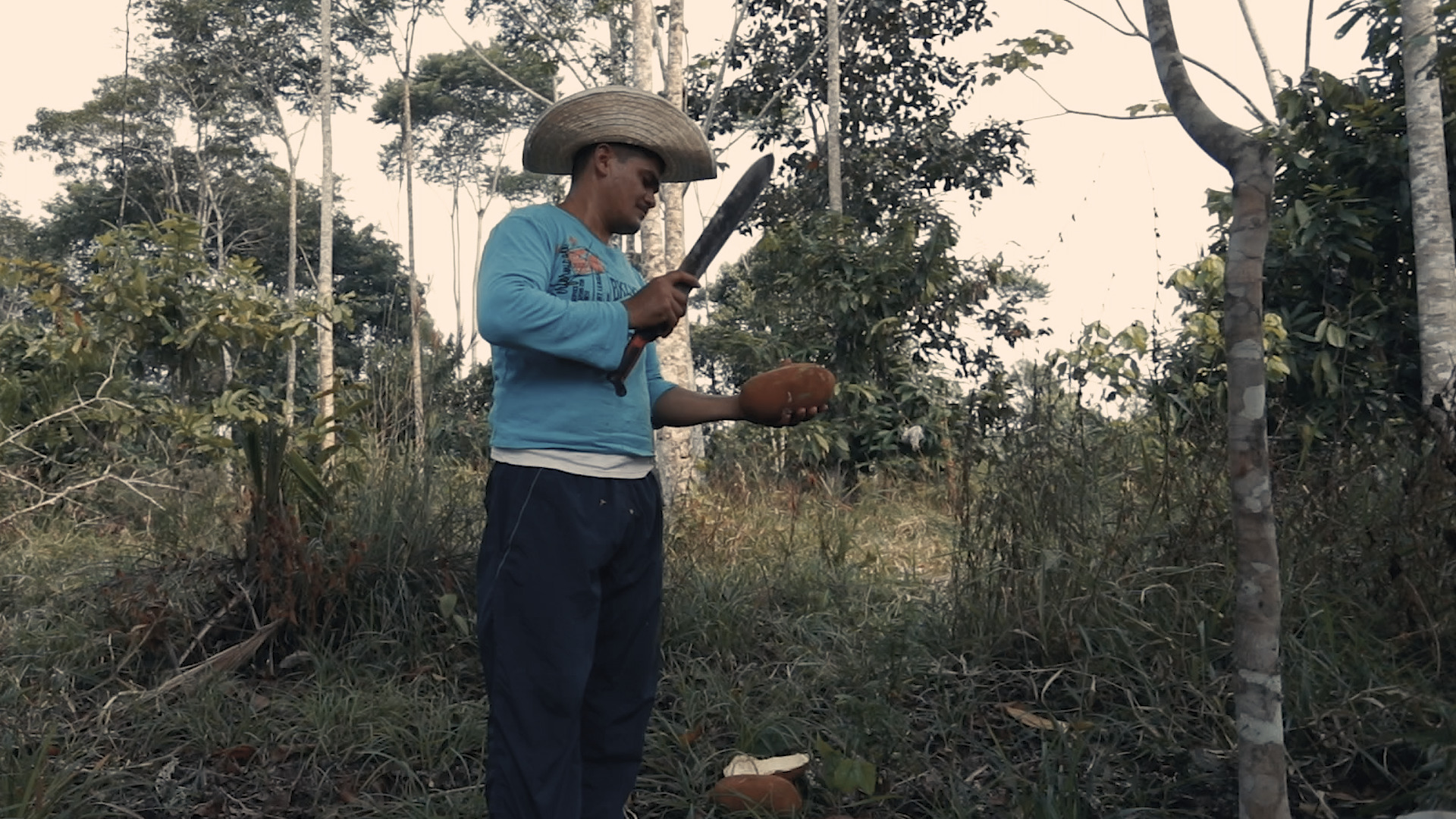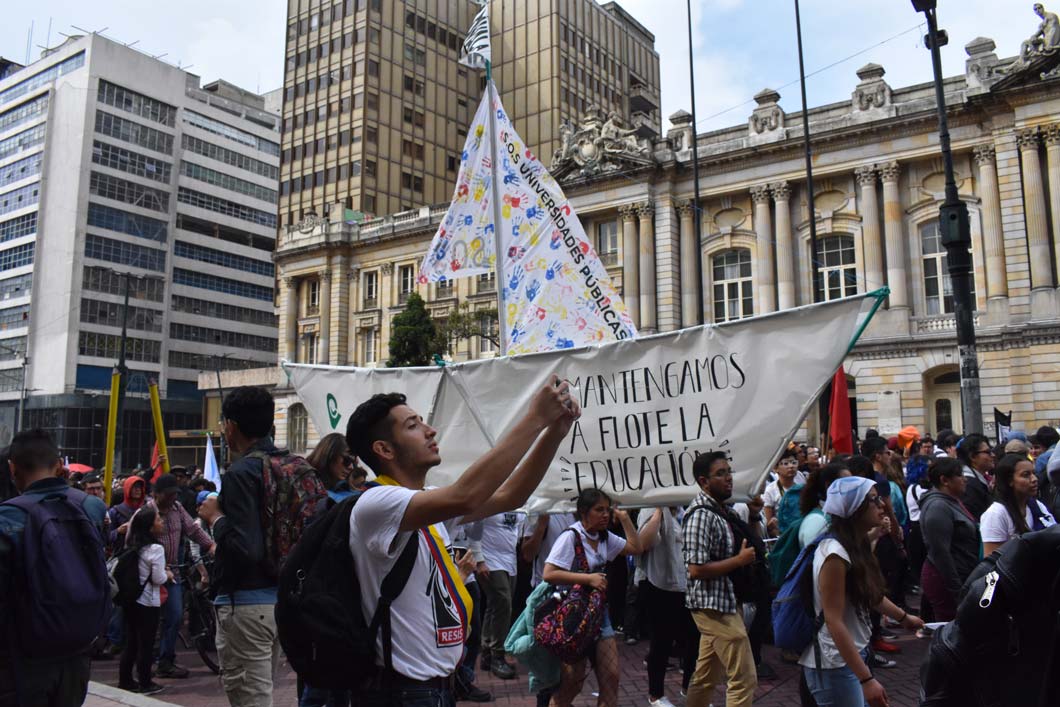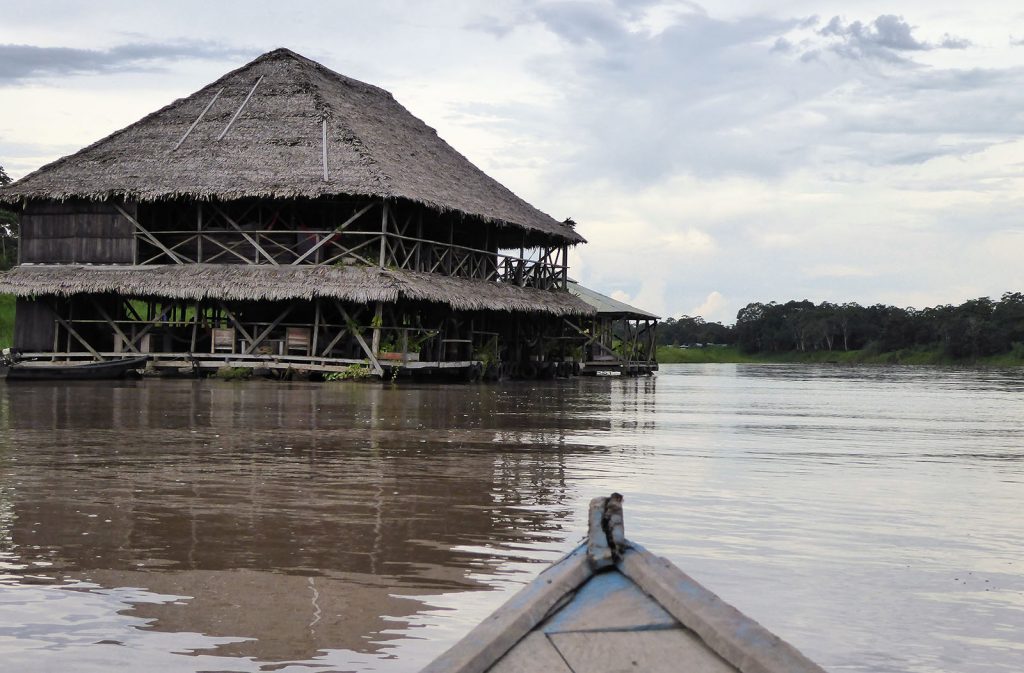
How better to experience the Amazon than on it?
Our man gets his feet wet (and much more besides) in Colombia’s sliver of the world’s mightiest river.
Jumping into the Amazon is not a good idea, I realise, seconds after hitting the warm brown water after leaping from a raft anchored mid-stream. The big river has long coiled through my imagination, but it’s not enough to look at it, read up on it, fly over it, walk its hot banks or skim over it in a variety of craft. No, I must go full immersion and feel its metaphorical pull turn into something more physical.
By now I am feeling a bit of a plonker. The current is much stronger than I expected, not at all like the slow drifting milk chocolate it appears from terra firma. Urgent swirls tug me past the raft and down towards Peru, Brazil and thousands of miles to the Atlantic Ocean. I change stroke to keep up. Now I am flapping like a panicked fish to keep level with the raft, which seems so to be disappearing across the turbulent water.
I should have remembered Apocalypse Now: ‘Don’t get out of the boat.’ This river is home to black caiman, green anacondas, red-bellied piranhas, electric eels, freshwater bull sharks, payara vampire fish and candirú, small spiny catfish that, according to jungle lore, swim up and hook into the human urethra. So far there is zero medical evidence for this legend, but why risk becoming the first case?
But the combined threat of these river rogues is nada compared to the force of the aqueous ambience. The real beast here is the Amazon itself. It’s not to be played with. Almost at the end of my endurance, I make a grab for the tyre fender dangling from the rotting balsa logs, haul myself up and flop onto the deck above.
“Why are you shaking daddy?” asks my son. “Maybe next time take us to a hotel in town with a swimming pool?” he adds, scoring another point in our ongoing ‘how-best-to-experience-the-Amazon’ conversation.
This usually boils down to A: stay in a nice hotel in the town of Leticia with an aircon and piranha-free swimming pool and make comfortable day-trips to the jungle. Or B: sleep in the jungle in an eco-lodge/tent/hut/hammock (‘eco’ in this case usually means poor plumbing and a broken generator). But we have found a third option: staying on the Amazon itself in a giant floating cabin.
And why not? “If we’re going to visit the Amazon, we might as well be on the Amazon,” I find myself repeating several times as we settle into our large upstairs living quarters on the Kurupira Floating Cabin. This two-story maloka is hewn from tropical hardwood, thatched with palm and floating on massive balsa logs anchored to the riverbed with concrete blocks and steel ropes to a nearby river island. It’s absurdly romantic but not at all practical (a 20-minute boat ride from Leticia), has limited electricity (three hours a day) and – shock, horror – no internet.
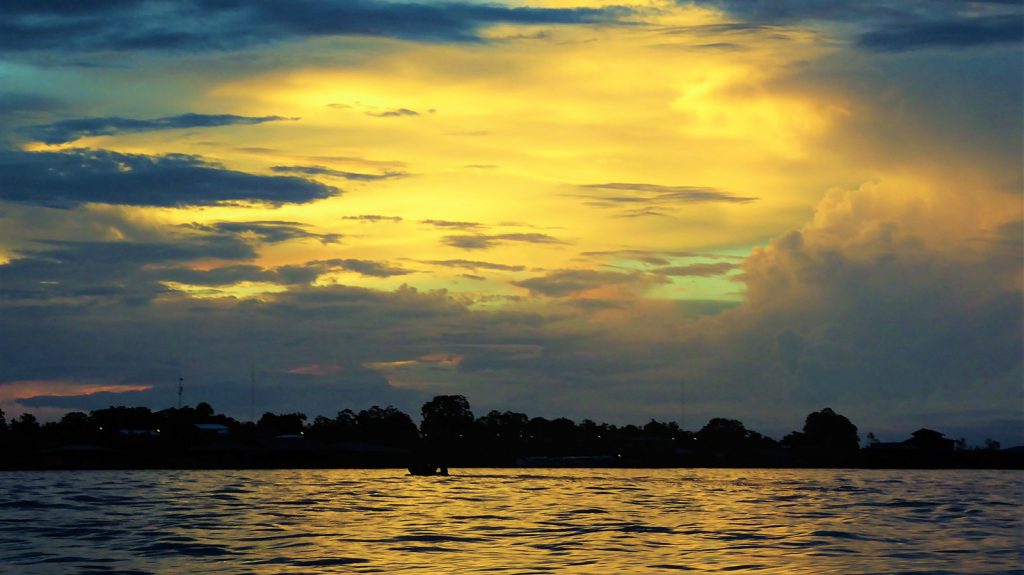
Who needs wi-fi with a sunset like this?
A world without wi-fi
Never mind surviving the jungle and river. How will we live sans wi-fi for three days?
The answer came in the form of Felix, the captain of the floating cabin. His easy smile and Tikuna heritage suggest someone at one with the Amazon, and soon we are falling into conversation on the finer points of how to collect giant balsa trunks to make rafts (cut one down then float it out to the big river during the flood season) and life on the river.
It’s tough work, even for a Tikuna, and Felix shudders at the memories of collecting the dozen or more two-metre-thick trunks for the good raft Kurupira.
“The logs slowly sink over the years and one day soon we will have to cut new ones,” he says. Meanwhile a variety of amazing life forms – fungi, lichens, plants, worms, beetles, frogs and even small trees – are taking hold on the waterlogged old ones and slowly turning Kurupira’s base into a living island. Below the waterline various river-life shelter in the eddies between the logs. Time to go fishing.
Felix hands us the fishing rods, which are sticks tied to thin line and a hook, and could be leftover props from a Tom Sawyer movie. Their very simplicity combined with the rich wooden smell of the raft, the cool river breeze, the open skies and flowing river evokes a genuine Huckleberry Finn moment as we prepare our bait – juicy grubs dug out of the raft logs – and find a corner to fish from.
Then, right on cue, the dark triangular fins and arched backs of two river dolphins break the surface just downstream. “They’ve come to push the fish to us,” shouts my daughter, and Felix nods in agreement.
I am intrigued to see what strange fish we might catch in these murky waters and am not disappointed. First up is a cucha, which has large glass eyes and armour plates that look as if they’ve been welded together by some Victorian steampunk inventor. Next on the hook is a golden catfish which hides some nasty venomous barbs so must be handled with care. After that is a matacaimán fish which, when gulped by a caiman, deploys two spring-loaded lateral fins which stick like flick-knives in the gator’s gullet. There it sits until the hapless would-be predator is dead.
The following catch, though, seems to break this mould. It is an elongated, almost finless, fish with delicate light-blue skin and pinprick eyes. How does this softie survive in the watery Gangs of New York knife-fight below?
The fish that nobody wants
The answer is with a thick coating of smelly mucus, which I now have on my hands, arms, shirt, shorts and legs. “Look, Dad’s getting slimed!” says one of my offspring with glee as I struggle to pin the wriggly critter to the deck and free it from the hook. “Yuk, don’t bring it over here,” says offspring number two. Even Felix pulls a face. “No-one wants to catch that fish,” he says.
In fact, we throw all the fish we caught back to Mama Amazon, but as recompense at lunchtime Felix brings us a feast of fried slabs of pirarucú, an ancient, air-gulping 200-kilo monster of a fish endemic to the Amazon and now farmed for its meat.
Fishing and fish farming is the main livelihood in this hugely nutritious river, and Felix shows me his own canoe with a ‘peque-peque’ motor which consists of a long steel shaft and propeller bolted directly to the driveshaft of a bog-standard small petrol motor, then mounted on a gimbal to the back of any canoe or small boat. The driver then dips the shaft in the water and revs the engine to move forward.
Of course, this economic design – four times cheaper to buy and five times cheaper to fuel and maintain than a custom outboard motor – is not just cutting costs, but anything else the spinning prop comes into contact with. The boat port in Leticia can get scary as dozens of small craft jostle for berths while waving what is in effect the business-end of a liquidiser in your face.
On the open river, though, the humble peque-peques are often more effective than outboards, explains Felix. This is because the long loose shafts of the peque-peque can be quickly and deftly lifted clear of the submerged timber, carried down by the powerful flow.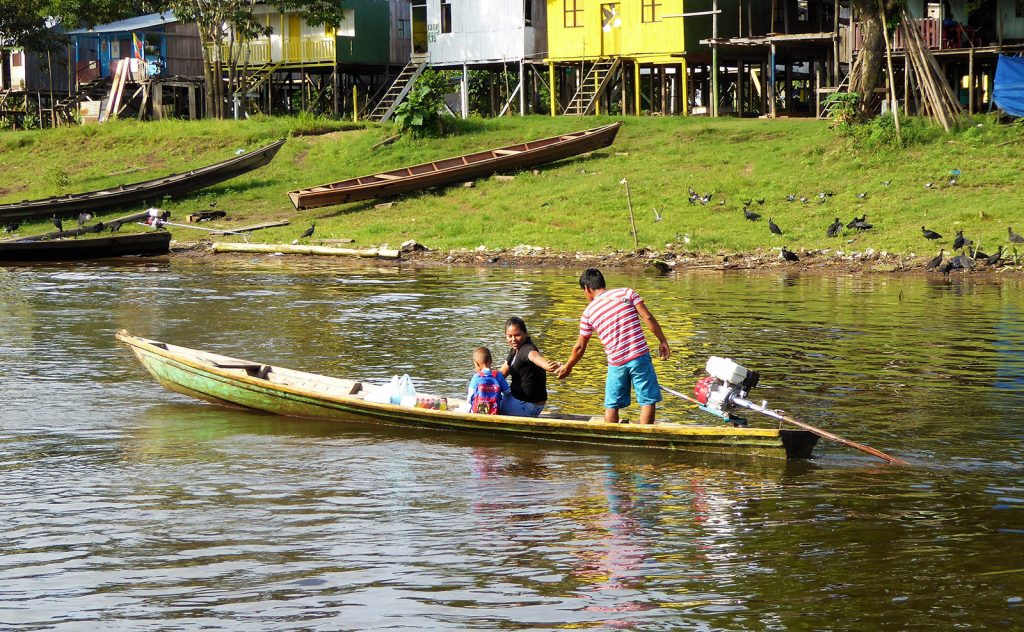
These motors have transformed many lives on the Amazon, he says: “Before you had to be rich to afford a proper outboard, but now with just a million pesos most people can buy a cheap canoe and peque-peque and catch fish to sell, or transport goods on the river.”
Inspired, we flag down a passing peque-peque – some operate like taxis – and at sunset motor out to the mid-point between Peru, Brazil and Colombia, with the jungle-clad banks so distant – the flow is five kilometres wide here – we feel more at sea than on a river. (“Are we in the ocean now?” quizzes my daughter.)
The world’s biggest river discharges 300,000 cubic metres per second, more than the world’s next ten biggest rivers combined, and drains a watershed of seven million square kilometres, overlapping six countries and leaves you feeling very small indeed. But somehow happy. I realise that I came here to see the jungle but instead found myself entranced by the river itself, and the people living on it.
Related: Gerald Barr on ‘Going Local’ in Bogotá
We motor back over the darkening water passing rows of floating houses, shops, workshops and aquatic fuel stations tethered to the river islands, some with humming generators, others with barking dogs, music and kids splashing. A Colombian warship looms out of the dusk. Then, silhouetted against the lights of Leticia, a man bales water from his canoe with a half-bucket.
Our candle-lit floating cabin is waiting with its river breezes and water gurgling under the anchored logs. I take to my hammock on the upper deck and watch a full moon rise through the treetops, while to the north an electric storm is lighting the banks of clouds crowding in.
Yes, what better way to experience the Amazon than to stay on it. But not in it. Leave that to the fishes.
Gerald Barr
Amazon travel: Need to know
Colombia borders a small section of the Amazon river upstream from Leticia, which can be reached from Bogotá by scheduled 2-hour flights with Avianca, Latam or Satena. Leticia is joined to the Brazilian town of Tabatinga. The two are continuous and there are no border formalities if you stay in the urban area. A short boat ride across the Amazon River is the Peruvian border town of Santa Rosa de Yavarí.
Many tour companies offer guided river and jungle trips as well as visits to indigenous communities, with options to visit either the Peruvian (south bank) or Colombian (north bank) of the Amazon. Flights and tours can be booked well in advance, which is advisable in the busy season (December-January and June-July), but at other times if you are not on a tight schedule, these trips can easily be booked in Leticia itself. There is regular public transport in public ‘bus boats’ along the river itself, or you can hire transport at the port in Leticia, including small peque-peque canoes, though these are only suitable for short trips (an hour or less) to nearby settlements.
Accommodation in the Kurupira Floating Cabin can be booked online at amazonheliconia.com. The cabin is a short canoe ride from Leticia, and trips to other parts of the river can be organised from the lodging.
The Amazon region can be uncomfortably hot and humid, and mosquitoes are voracious. Pack good insect repellent, light cotton/linen long-sleeved shirts and trousers, a sun hat and raincoat.



